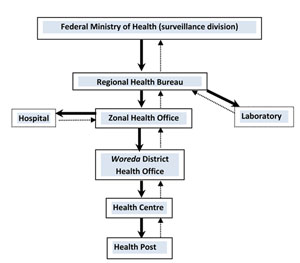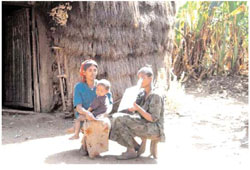40.6.2 Active surveillance
The second type of surveillance is called active surveillance, in which the health professionals actively seek to collect data from all possible cases in their area, under instruction to do so from a higher level in the health system. Active surveillance is usually conducted in relation to a specific disease or disorder, or it seeks to assess the takeup of a particular health service (e.g. family planning or immunization). Active surveillance data are collected because the higher health authorities request a specific surveillance report, instead of waiting for Health Posts or other health facilities to send them routine reports. In this sense, it is the opposite of passive surveillance.
Figure 40.6 shows the information flow under active surveillance in Ethiopia. The solid black arrows indicate that the FMOH, at the highest level of the health system, takes the first step and requests surveillance data from all lower levels of the health system. Intermediate levels contact those below, all the way down to the level of your Health Post. As the broken arrows show, your Health Post prepares the requested data and sends it back to the Health Centre, the Health Centre sends the data to the woreda District Health Office, and so on to the highest level. Note, that without a request from a higher level, the active surveillance report would not have been prepared and submitted.

Active surveillance can also be a type of event-based surveillance, which refers to unstructured data gathered from sources such as media reports, community concerns and rumours. For example, if there is a rumour about a measles outbreak in your community, the Health Centre will ask you to report if there are any new cases of measles during a defined period of time.
You will then have to actively collect data about new cases of measles by making house-to-house visits in your catchment area and reporting back to the Health Centre (Figure 40.7).

40.6.1 Passive surveillance
